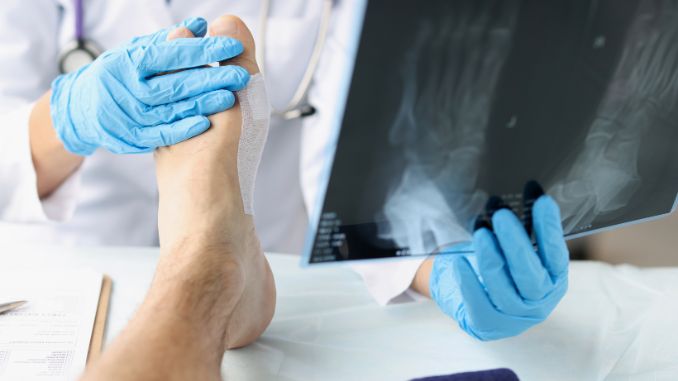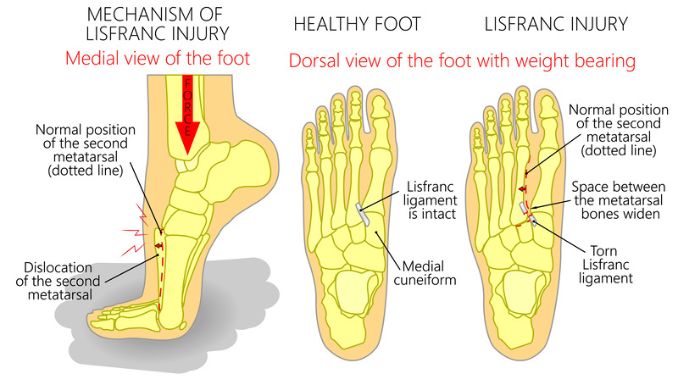A midfoot sprain [¹] is a type of foot sprain that occurs when the ligaments connecting the bones in the middle of your foot, known as the tarsal bones, are stretched or torn. This often painful condition can significantly impact daily activities and athletic performance. Proper understanding, diagnosis, and treatment are crucial for optimal recovery.
What is a Midfoot Sprain?

The midfoot [²], also known as the middle region of the foot, is a complex anatomical area composed of five tarsal bones that form the foot's arch. Ligaments stabilize these bones, connecting them to the foot’s other structures. A midfoot sprain occurs when these ligaments are overstretched or partially or completely torn.
What causes Midfoot Strain and Symptoms
Midfoot sprains commonly result from:
- Sudden twisting or inversion of the foot: often happens during sports activities like basketball, soccer, or dance.
Direct impact: A forceful blow to the midfoot can also cause a sprain.
Overuse: Repetitive stress on the foot, such as long-distance running or hiking, can contribute to ligament damage.
Symptoms of a midfoot sprain typically include:
Pain: Sharp or aching pain in the arch of the foot.
Swelling: Inflammation and puffiness in the injured area.
Bruising: Discoloration of the skin around the midfoot.
Tenderness: Pain when pressure is applied to the injured area.
Difficulty walking: Pain and instability when bearing weight.
Limping: An altered gait to avoid putting weight on the injured foot.
Midfoot sprain symptoms can overlap with other more severe injuries, highlighting the importance of accurate diagnosis.
Diagnosis and Initial Response to Lisfranc Injury
A healthcare professional will conduct a thorough physical examination to diagnose a midfoot sprain accurately. They will assess the foot's range of motion, tenderness, and stability. Imaging studies, such as MRI scans or X-rays, may be requested to rule out fractures or other underlying conditions. A Lisfranc injury is a severe midfoot sprain that requires an accurate diagnosis.
Midfoot Sprain Recovery at Home

Disclaimer: While home care can effectively manage mild to moderate midfoot sprains, it's critical to consult a healthcare professional for proper diagnosis and treatment.
Initial Care
The initial recovery phase focuses on reducing pain, swelling, and inflammation. This can be achieved through the RICE method:
Rest: Avoid physical activities that put weight on the injured foot. Use crutches if necessary.
Ice: Apply ice packs wrapped in a cloth to the injured area for 15-20 minutes every few hours. Avoid direct contact with ice.
Compression: Use an elastic bandage to reduce swelling and provide support. Ensure it's not too tight to avoid restricting circulation.
Elevation: Keep the foot elevated above heart level to minimize swelling.
Pain Management
Once the initial pain and swelling subside, gentle exercises can help restore strength and flexibility. These may include:
Alphabet tracing: Draw letters in the air with your injured foot to improve ankle mobility.
Towel curls: Sit with your foot flat on a towel. Try to scrunch the towel with your toes.
Calf stretches: Stand facing the wall with one foot back and heel down, then lean forward to feel the stretch in your calf. Hold for 20-30 seconds and switch legs.
Note: Always consult a physical therapist or healthcare provider for specific exercise recommendations based on your injury.
Footwear
Choose supportive footwear with good arch support to help alleviate pressure on the injured foot. Consider using orthotic inserts if recommended by a healthcare professional.
Gradual Weight-Bearing
As pain and swelling decrease, you can gradually start putting weight on the injured foot. Begin with short periods of weight-bearing and gradually increase the time.
Monitoring for Complications
It's essential to monitor for signs of complications, such as:
- Increased pain or swelling
Persistent redness or warmth
Fever
Inability to bear weight
Numbness or tingling
If you experience any of these symptoms, seek medical attention promptly.
Remember, healing takes time. Be patient and consistent with your home care routine. If your concerns or symptoms worsen, consult a healthcare professional.
Treatment Options
Treatment for a midfoot sprain depends on the severity of the injury. Options include:
- Non-surgical treatment: Most midfoot sprains can be effectively treated without surgery. This typically involves rest, ice, compression, elevation, pain management, and physical therapy.
Immobilization: In some cases, wearing a walking boot or cast may be necessary to protect the injured foot and allow the ligaments to heal.
Physical therapy: A physical therapist can develop a personalized exercise program to strengthen the muscles around the midfoot, improve flexibility, and restore normal function.
Orthotics: Custom-made orthotic inserts can support and alleviate pressure on the injured area.
Surgery: Severe midfoot sprains with complete ligament tears or associated fractures may require surgical repair. Surgical treatment may involve realigning and stabilizing the midfoot bones and joints to restore function and alleviate pain.
Midfoot Sprain Recovery Time
The recovery time for a midfoot sprain varies depending on the severity of the injury and individual factors such as age, overall health, and adherence to the treatment plan. Mild sprains may heal within a few weeks, while more severe sprains can take several months.
Rehabilitation exercises are crucial to restore function and strength to the affected foot.
Preventing Future Midfoot Sprains
To reduce the risk of recurring midfoot sprains, consider the following preventive measures:
- Proper footwear: Wear shoes that provide cushioning and adequate support.
Strengthening exercises: Build strength in the muscles of the feet, ankles, and lower legs.
Flexibility training: Improve the flexibility of the foot and ankle joints.
Warm-up and cool-down: Incorporate these routines before and after physical activity.
Cross-training: Engage in activities that provide variety and reduce foot stress.
These preventive measures can help reduce the risk of foot sprains.
When to Seek Medical Attention and Physical Examination

It is very important to talk to a doctor if you have lasting pain, swelling, trouble walking after hurting your midfoot, or if you think you may have a broken bone. Also, see a doctor if the pain is very bad, or if you feel numbness, tingling, or weakness.
Disclaimer: This information is intended for general knowledge and informational purposes only and does not constitute medical advice. Always consult a qualified healthcare professional to diagnose and treat any medical condition.
By understanding the nature of midfoot sprains and following appropriate treatment and prevention strategies, you can effectively manage this common injury and promote optimal recovery.
Conclusion
A midfoot sprain is when the middle part of your foot gets hurt. This can be very painful and make it hard to do everyday things or play sports. It’s important to know what causes it, what the signs are, and how to treat it. With the right care and time to heal, most people get better and can do their normal activities again. But if the pain gets worse or doesn’t go away, it’s important to see a doctor. Taking care of your foot and doing the right exercises is very important to heal from a bad sprain. Be patient and keep following your treatment to get better. If you think you have a midfoot sprain or foot pain, see a doctor to find out what’s wrong and get the right help.
Don’t let an ankle sprain slow you down! Discover proven solutions to heal faster and get back to doing what you love. Click here to learn more and take the first step toward recovery today!








